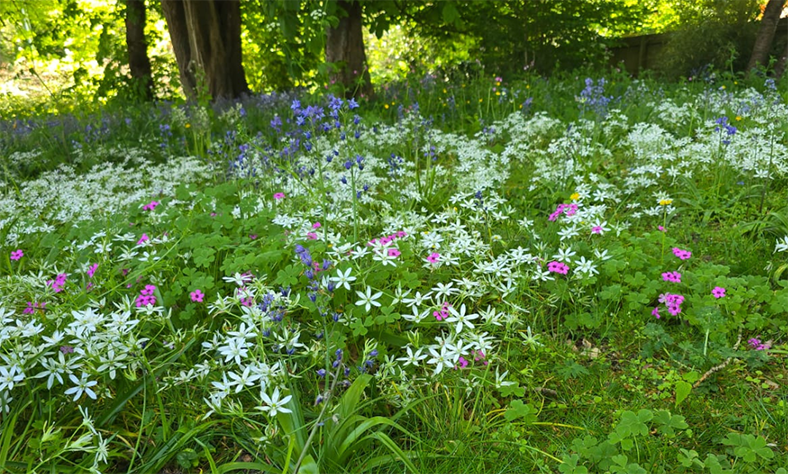
The Top 5 Benefits of Wildflowers for Commercial Landscapes
Sustainability and biodiversity are key considerations for many outdoor spaces. Enhancing these areas in ways that are not only visually stunning but also environmentally beneficial is becoming a priority. One of the most effective, and increasingly popular, options is the introduction of wildflower areas.
Whether you manage a business park, school grounds, public green space, or a residential estate, incorporating wildflowers brings a wide range of advantages.
Boost Biodiversity with Wildflowers
Wildflowers create a rich, diverse habitat for pollinators like bees, butterflies, hoverflies, and other beneficial insects, which are vital to healthy ecosystems. They also attract birds and small mammals, providing food, shelter, and nesting opportunities.
By planting wildflowers, you actively support local wildlife and help reverse the decline of pollinating species. This biodiversity boost is essential, especially in urban and semi-urban environments where natural habitats are increasingly fragmented or lost.
Additionally, incorporating wildflowers into your landscape sends a strong, visible message about your organisation’s commitment to environmental responsibility. In an era of growing ecological awareness, this can positively influence how your site is perceived by stakeholders, clients, and the local community.
Transform Your Landscape with Natural Beauty
Few features can rival the visual appeal of a meadow in full bloom. Wildflowers add vibrant colour, natural movement, and seasonal variation that standard lawns, hedging, or shrub beds often lack.
A well-designed wildflower area can quickly become a focal point on your grounds, offering a refreshing contrast to manicured spaces. The aesthetic impact isn’t just cosmetic; it contributes to employee wellbeing, public satisfaction, and tenant appeal. Studies have shown that exposure to natural, biodiverse spaces can improve mental health, boost creativity, and reduce stress levels (National Library of Medicine, 2022).
Whether it’s bright cornflowers in summer or delicate oxeye daisies in spring, wildflower meadows offer year-round visual interest that enhances the identity of your site.
Improve Climate Resilience
Native wildflowers are well adapted to local soil and climate conditions, giving them an advantage when coping with drought, extreme weather, or pests. Their root systems improve soil structure, increase rainwater absorption, and reduce erosion. This makes wildflower areas a practical choice for landscapes that need to withstand increasingly unpredictable weather patterns.
Improve Resilience with Native Planting
Wildflower meadows aren’t just beautiful, they’re tough and adaptive. Native wildflowers are well-suited to local climate conditions and soil types, making them more resilient to drought, disease, and pests.
This resilience supports your site’s climate adaptation strategies. Wildflowers help:
- Improve soil structure
- Absorb rainwater runoff
- Reduce erosion
- Maintain ground cover during dry spells
As climate patterns shift, traditional lawns and ornamental plants may struggle with extreme weather conditions. Wildflowers, on the other hand, thrive in challenging environments with minimal intervention, making them a smart choice for future-proofing your landscape.
Showcase Your Sustainability Commitments
Demonstrating a commitment to sustainability is no longer a “nice to have”, it’s a business imperative. Clients, tenants, and local authorities increasingly value environmental responsibility.
Introducing wildflowers can help you:
- Align with biodiversity net gain goals
- Support ISO 14001 environmental management systems
- Qualify for green building certifications (e.g., BREEAM)
- Engage with local councils or schools on biodiversity projects
Wildflower areas are a simple yet powerful way to meet these targets. They’re also highly visible, making your commitment obvious to anyone who visits your site.
From community engagement to corporate reporting, wildflower projects are an excellent way to amplify your green credentials.
FAQs About Wildflower Areas
Q: When is the best time to plant wildflowers in the UK?
A: The best times to sow wildflowers are autumn (September–October) and spring (March–May). Autumn sowing allows seeds to settle over winter, leading to early blooms, while spring sowing suits quick-establishing annuals.
Q: Do wildflower areas need special soil?
A: Most wildflowers prefer low-nutrient soils, so sites often don’t need fertilisation. If the soil is too rich, some preparation may be required to reduce nutrient levels, such as removing topsoil or planting a green manure crop beforehand.
Q: Can wildflowers grow in shaded areas?
A: Some wildflower species tolerate partial shade, though most prefer full sun. At Countrywide, we select seed mixes that are customised to your site’s conditions, including shade-tolerant species if necessary.
Q: How long before the wildflower meadow becomes established?
A: You can expect initial blooms in the first year, especially with annuals. However, full establishment, especially with perennial meadows, typically takes 2–3 years, with each season bringing increased diversity and colour.
How Countrywide Grounds Can Help
If you’re looking for a cost-effective, visually impactful, and environmentally conscious way to improve your landscape, wildflowers are the answer. At Countrywide Grounds Maintenance, we make the process simple and effective, no matter the size or scope of your site.
Contact us today to arrange a consultation and discover how wildflower planting can transform your grounds.

